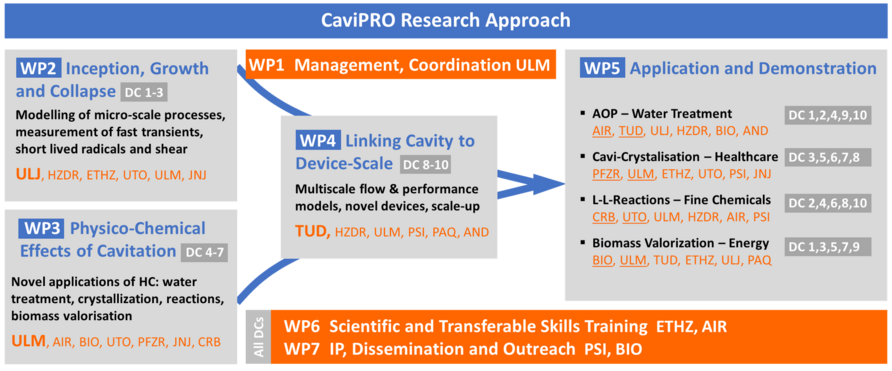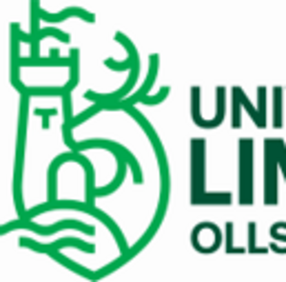CaviPRO: Overarching goal of is to develop new knowledge, methods, models & data for realising innovative hydrodynamic cavitation devices and substantial productivity enhancements in key sectors (water, healthcare, chemicals and energy). This will be achieved through research of ten doctoral students (DC1 to DC10) with CaviPRO partners. The overall work will be executed via six work packages:

ULM: University of Limerick, TUD: Technische Universität Dresden, HZDR: Helmholtz-Zentrum Dresden-Rossendorf, UTO: University of Turin, ULJ: University of Ljubljana, AIR: Air Liquide S.A., BIO: Biocore Environmental, ETHZ: Swiss Federal Technical Institute, PSI: Paul Scherrer Institut, JNJ: Johnson & Johnson, CRB: CRB Benelux BV, AND: Andritz, PFZR: Pfizer, PAQ: Paques Global BV
WP1 Covering the management of the network, WP1 will involves all beneficiaries and partners as well as one elected representative of the DCs. This strategic WP will be instrumental in achieving the research and training objectives and ensuring the highest quality and uniform development of all DCs.
WP2 This WP focuses on the fundamentals of micro-scale processes in hydrodynamic cavitation (HC) and involves 2 beneficiaries (ULJ, HZDR) and ETHZ as primary centres with DCs1 to 3. Five other consortium members (UTO, ULJ, JNJ, BIO, and PFZR) are involved for co-supervision and secondments. It aims to provide an advanced understanding of the bubble inception, growth and collapse of cavities. The knowledge produced here will be fundamental and at the forefront of what can be achieved with current experimental and simulation techniques. The knowledge acquired in WP2 will inform the design options that will be used in WP3 and WP4 for their integration in more complex environments and finally close to real-world applications in WP5. To maximise the research outputs, DCs will be linked in this WP e.g. through the collaboration of DCs 1 to 3 and, across the other WPs, through the collaboration with other DCs.
WP3 This WP involves 4 beneficiaries (AIR, BIO, UTO and ULM) as primary centres and four DCs (DC4 to DC7). Seven other consortium members (HZDR, ETHZ, ULJ, PSI, PFZR, JNJ, and CRB) are involved for co-supervision and secondments. DCs 4 to 7 will study the physico-chemical effects of cavitation in interaction with shear, OH radical formation, chemical reactions and separation. WP3 thus bridges WP2 and WP4, because if one wants to make use of cavitation in technologically relevant applications, the question of their integration in different configurations will play a pivotal role. The DCs are linked in this WP through the collaboration of DCs 4 to 7 and across the other WPs, e.g. through collaboration with DCs 1 to 3 and DCs 8 to 10.
WP4 This WP will develop validated computational models for simulating performance of HC devices and will involve 2 beneficiaries (TUD and ULM) and PSI with DCs 8 to 10. Four other consortium members (UTO, AIR, PAQ, and AND) are involved for co-supervision and secondments. This WP uses the results obtained in WP2 and WP3 to develop the necessary tools and models for creating HC demonstrations in WP5. It will also develop new HC devices and internals, which will realise performance levels that have been unattainable until now. The guidelines for design, optimisation and scale-up of HC devices and processes will be developed. The DCs are linked in this WP through the collaboration of DCs 8 to 10 and across the other WPs, e.g. through collaboration of DCs 1 to 7.
WP5 Thanks to the involvement of all 7 beneficiaries (ULM, TUD, HZDR, UTO, ULJ, AIR and BIO), 2 academic partners (ETHZ, PSI), 5 industry partners (PAQ, PFZR, CRB, AND, and JNJ), and all ten DCs, WP5 will demonstrate the next generation of HC applications for water treatment, cavi-crystallisation, organic reactions and liquid-liquid emulsions. Vigorous exchange of information among WP2 to WP4 will be ensured to help solve any issue encountered and to optimise the functionality of the systems. In addition, questions related to efficiency, costs, and the robustness of the developed systems will be central and discussed with our industrial partners. The structure of the CaviPRO network is designed to achieve our scientific objectives within specified timelines and budgets.
WP6 The training of the DCs will be conducted through local and network-wide activities and monitored in WP6, involving all consortium members (7 beneficiaries and 11 partners).
WP7 In WP7, DCs1-10 will work with CaviPRO partners on communication, dissemination (particularly ELS, EFCE) and exploitation of the results through advanced data management and open science approaches.



